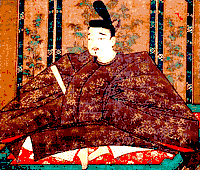Emperor Nintoku
Emperor Nintoku (仁徳天皇, Nintoku-tennō) was the 16th emperor of Japan,[1] according to the traditional order of succession.[2] Historians consider details about the life of Emperor Nintoku to be possibly legendary, but probable.[3] The name Nintoku-tennō was created for him posthumously by later generations.
| Nintoku | |
|---|---|
| Emperor of Japan | |
 | |
| Reign | legendary |
| Predecessor | Ōjin |
| Successor | Richū |
| Born | legendary |
| Died | legendary |
| Burial | Mozu no Mimihara no naka no misasagi (Osaka) |
No certain dates can be assigned to this emperor's life or reign.[4] The conventionally accepted names and sequence of the early emperors were not to be confirmed as "traditional" until the reign of Emperor Kammu, who was the 50th monarch of the Yamato dynasty.[5]
Traditional history change
According to Nihon Shoki, Nintoku was the fourth son of Emperor Ōjin and the father of three emperors — Richū, Hanzei, and Ingyō .
Events of Nintoku's life change
Very little is known about the events of Nintoku's life and reign. Only limited information is available for study prior to the reign of the 29th monarch, Emperor Kimmei.[6]
Nintoku's reign is marked by Japan's first large-scale engineering projects.[7]
After his death change
This emperor's official name after his death (his posthumous name) was regularized many centuries after the lifetime which was ascribed to Nintoku.[8]
According to the Imperial Household Agency, the emperor's final resting place is in an earthen tumulus (kofun) at Sakai.[9] Nintoku is venerated at a memorial Shinto shrine (misasagi) which is associated with the burial mound.[1]
Related pages change
References change
- ↑ 1.0 1.1 Imperial Household Agency (Kunaichō), 仁徳天皇 (16); retrieved 2011-10-16.
- ↑ Titsingh, Isaac. (1834). Annales des empereurs du japon, pp. 22-24; Varley, Paul. (1980). Jinnō Shōtōki, pp. 110-111; Nussbaum, Louis-Frédéric et al. (2002). "Nintoku Tennō" in Japan encyclopedia, p. 716.
- ↑ Kelly, Charles F. "Kofun Culture," Japanese Archaeology. April 27, 2009; retrieved 2011-10-16.
- ↑ Ponsonby-Fane, Richard. (1959). The Imperial House of Japan, p. 30.
- ↑ Aston, William George. (1896). Nihongi, pp. 109.
- ↑ Titsingh, pp. 34-36; Brown, pp. 261-262; Varley, pp. 123-124.
- ↑ Aston, William. (1998). Nihongi, Vol. 1, pp. 254-271.
- ↑ Aston (1998), pp. 146-147.
- ↑ Parry, Richard Lloyd. "Japan guards the emperors' secrets; Ban on digs in ancient imperial tombs frustrates archaeologists," The Independent (London). 12 November 1995; retrieved 2011-10-16.
Other websites change
Media related to Emperor Nintoku at Wikimedia Commons
| Preceded by Emperor Ōjin |
Legendary Emperor of Japan Nintoku 313-399 (traditional dates) |
Succeeded by Emperor Richū |